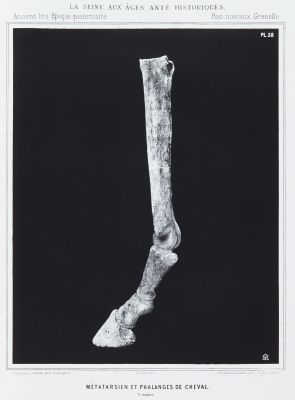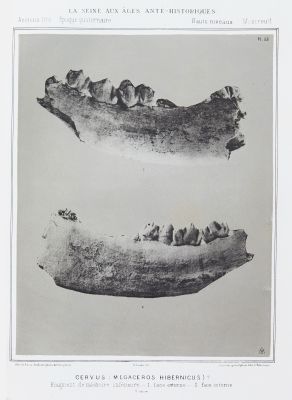
Title
Coupe de la sablière DoucetArtist
UnknownPublication
La Seine aux âges anté-historiquesDate
1883Process
PhotogravureAtelier
DrivetImage Size
19.5 x 25 cm
Drivet is not one of the early photogravure practitioners usually discussed. Waterhouse mentioned him in his essays in the Photographic News and displayed one of his prints at the Victoria and Albert. Samuel Wagstaff had a Drivet print in his photomechanical exhibit at the Grolier Club, and Andre Jammes exhibited a Drivet at his Intaglio exhibit in Switzerland. The process of Drivet for engraving plates is not described, but the principle of it can be gathered from the specification of the patent. At the same that the image of the object is exposed on a prepared collodion plate in the camera, the image of a sheet of white paper, covered with closely ruled black lines, is exposed upon the same plate, and at the same time, through another opening from an exactly opposite direction. A negative is thus obtained which would print a positive picture having the required lines in the high lights obliterated, and intensely developed in the deep shadows. A gelatin picture printed as in woodbury’s process, gives the matrix from which an electrotype plate is produced, to be printed from as an engraved copper plate the results are undoubtedly the most beautiful and practical yet achieved.
Drivet was a lithographer and printer working France. He developed two heliogravure processes: one incorporated an aquatint grain, and the other utilized a line screen. Both of Drivet’s processes can be seen in the 1869 La Seine aux âges anté-historiques, though few exist outside this publication. According to an 1867 report of the Paris Commission, “The process of Drivet for engraving plates is not described, but the principle of it can be gathered from the specification of the patent. At the same time that the image of the object is thrown on the prepared collodion plate in the camera, the image of a sheet of white paper, covered with closely ruled black lines, is thrown upon the same plate, and at the same time, through another opening from an exactly opposite direction. A negative is thus obtained which would print a positive picture, have the required lines in the highlights obliterated, and intensely developed in the deep shadows. A gelatin picture printed as in woodbury’s process, gives the matrix from which an electrotype plate is produced, to be printed from as an engraved copper plate. It will be seen that we have here the very elements of mezzotint engraving, and the results are undoubtedly the most beautiful and practical yet achieved.” [1]
Eugène Belgrand (1810-1878) was a French engineer who made significant contributions to the modernization of the Parisian sewer system during the 19th century rebuilding of Paris. Prior to 1850, the water system in Paris was inadequate for its growing population. Wastewater was discharged into the Seine, a primary source of the critically limited supply of drinking water. Baron Haussmann, tasked by Napoléon III to modernize the city, appointed Belgrand as Director of Water and Sewers of Paris in March 1855. Belgrand embarked on an ambitious project. The tunnels he designed were intended to be clean, easily accessible, and substantially larger than the previous Parisian underground. By 1870 he created an innovating network of underground pipes to prevent Paris from being flooded. Under his guidance, Paris’s sewer system expanded fourfold between 1852 and 1869. He also addressed the city’s fresh water needs, constructing a system of aqueducts that nearly doubled the amount of water available per person per day and quadrupled the number of homes with running water.
Public reaction to the improvements was overwhelmingly favorable, supported by tours of the newly constructed sewer system and a series of photographs taken by Nadar, pioneering the use of artificial lighting for photography. Belgrand shared his insights with others, writing "monumental publications" such as this portfolio detailing his work and the science behind it. Belgrand’s projects remain "one of the most extensive urban sewer systems in the world" and served as a "transitional phase" leading to modern wastewater processing. To commemorate his work in Parisian civil engineering, Belgrand’s name is one of 72 names engraved on the Eiffel Tower”
The plates that make up this volume have not been are in a special héliolithographie process applied in full for the first time in the workshops of the Service des Travaux historiques, and excluding the possibility of error. Vol. I [Texte] contains 5 plates from photographs by Drivet’s two heliogravure processes, on in lined half-tone and the other in random dot process. Vol. II [Planches de paléontologie] contains 79 plates, 4 of them by Drivet in lined half-tone and the rest in photolithography by A. Bilordeaux in association with E. Lacan. [2]
References
[1] Hanson, David A. Checklist of Photomechanical Processes and Printing, 1825-1910. , 2017. p. 43.
[2] Hanson Collection catalog, supplement











